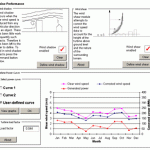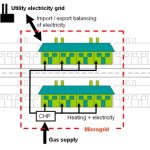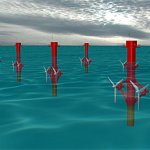The Arabian Peninsula (AP) is bounded between 10oN and 35oN latitude and 35oE and 60oE longitude with a spatial extent, which includes the offshore areas of the Red Sea, the Gulf of Aden, the Arabian Gulf, and the northern part of the Arabian Sea. AP encompasses the countries of Bahrain, Kuwait, Oman, Qatar, Kingdom of Saudi Arabia (KSA), United Arab Emirates (UAE), and Yemen. Most of these countries rely on fossil fuel for their electricity supply.
Offshore wind energy potential in the AP region has not been fully investigated. Therefore, the new Representative Cost Ratio was used to to estimate the offshore wind energy suitability distribution for the seven countries in the AP. The methodolgy used and the results were published recently on the Renewable Energy Journal Volume 152, for more details about the approach. Click here.
The identified sites were analysed in terms of potential power capacities based on an 8 MW wind turbine which now seems to be the standard capacity being deployed in Europe and elsewhere. The results shown in suitability map indicate a cumulative regional capacity of up to 35 GW for the turbine capacity selected. This Middle East region has not seen any significant or meaningful development to exploit its offshore wind energy potential and this work and its outcomes has also addressed this gap in knowledge. The outcomes represent the first detailed assessment of the offshore wind energy potential for the Arabian Peninsula countries. This work will contribute to the stimulation of interest in the region of the importance of offshore wind as part of a regional energy mix.

Offshore wind energy Suitability Map around the Arabian Peninsula. Where zero score is not a suitable area, while a score of one represents areas of the highest possible suitability.
Latest updates:
ECCD present at the International Conference on Sustainable Energy, SET 2023 in Nottingham, UK 2023 
ECCD presented 8 papers at the 20th International Conference on Sustainable Energy (SET 2023), Nottingham, UK, with Professor Bahaj also presenting a keynote address
UK Micro Wind Trial 2007 
The UK has the best wind resource in Europe and this is now starting to be harnessed through both on-shore and off-shore multi-MW scale wind farms. Whilst performance figures for commercial wind farms are well known, no comparable data exists for the micro wind market. ECCD is part of the UK micro wind trial which is ...
The story of the 'Smiths' in their 1930's semi 2007 
Residential housing accounts for more than a quarter of the UK’s primary energy consumption. This is primarily in the form of space heating (typical 3 bedroom UK house 20,000 kWh per annum) with electrical demands being much lower at around 4,000 kWh per annum. The gradual tightening of building regulations means that modern housing consumes ...
Photovoltaics in Residential Applications 2007 
Residential grid connected PV systems are relatively simple to design with easy to predict annual yields. However, the headline economics of residential PV in the UK are at present unattractive. A typical small residential PV system (1 to 3 kWp) as shown in the top figure would cost in the year 2000 around £4,500 per ...
Micro Wind Modelling Tool 2007 
Within the framework of a research project funded by the Economic & Social Research Council (ESRC) a micro wind modelling tool has been developed by SERG prompted by the imminent arrival of the technology. The tool allows the user to define a particular micro wind turbine and simulate its performance at various locations in the UK. Various ...
Assessment of Urban Microgeneration Solutions 2004 
The group’s research is looking at existing housing developments from the 1970s, 1980s, 1990s and 2000s to determine the scope and potential impact of microgeneration technologies and energy efficiency measures on the residential scale.
Hydrodynamics of Marine Current Turbines for Electrical Power Generation 2002 
Marine current turbines can play an important part in achieving an increase in electricity generation from renewable resources, but the development of the required technology will demand significant research effort. This project will lead to a better understanding of the design implications of some of the features that distinguish marine current turbines from wind turbines, ...
PV Roof Tile Development – POWERTILE 2000 
ECCD has developed a PV roof tile through Powertile Ltd which is now sold under license by Marley Eternit. A test roof at the University, which is shown in Figure 3, is used for prototype assessment and analysis of the thermal behaviour of different roof constructions.
